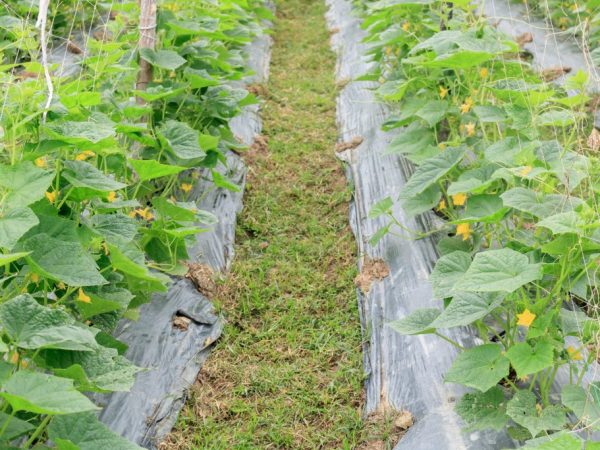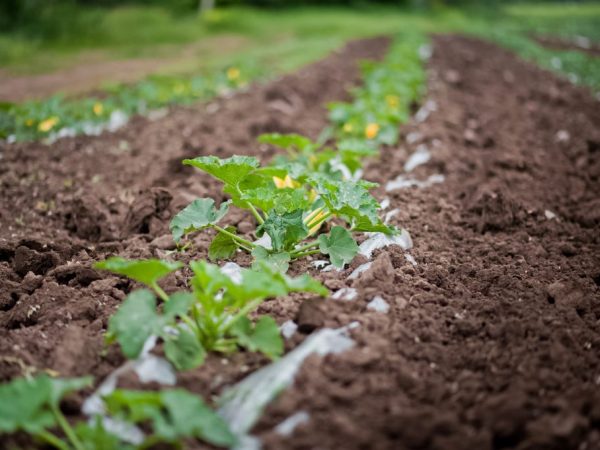Rules for growing cucumbers under spunbond
Recently, some summer residents have adapted to growing cucumbers under spunbond, preferring this method to the usual one. This method of growing vegetables is especially suitable for those who live in areas with cold climates. Growing cucumbers on spunbond, with the correct application of this method of growing vegetables, gives high yields and provides optimal conditions for the growth and development of cucumber bushes throughout the calendar year.

Rules for growing cucumbers under spunbond
Method description
Agrofibre, or spunbond, is an alternative to the well-known polyethylene, which gardeners have been using in the cultivation of vegetables for many years. This material is made from an environmentally friendly polypropylene component with a fine fiber structure.
The essence of the method of growing cucumbers on spunbond is to create a favorable climate for plants at cold air temperatures and insufficient sunlight in northern regions with short summers and at the same time at elevated temperatures in areas with a steaming sun.
Varieties of spunbond
Spunbond for agricultural needs can be used in several of its types:
- a white material that is used in open soil conditions, its density is 17-30g per 1 sq.m,
- white polypropylene with a density of 30 to 60g per 1 sq. m, used for greenhouse and greenhouse structures,
- black density of which is from 50 to 60g per 1 sq. m, used when mulching soil,
- black and white spunbond with a density of 50g per 1 sq. overheating,
- white-red, yellow-red materials that protect vegetables from bad weather.
Pros and cons of the method
Among the main advantages of using spunbond in the cultivation of cucumbers and other vegetable crops:
- the softness and lightness of the material, which, when covering the bushes, does not damage or injure them,
- light transmission of polypropylene, which makes it possible to provide plants with a sufficient amount of light, while preventing overheating,
- air and moisture permeability, which provides ventilation under the covering material and makes it possible for water to flow into the soil,
- UV resistance,
- the ability to accumulate and retain heat,
- ease of use, durability and relatively cheap price.
Spunbond in the process of use can be washed, glued and stitched, which gives additional advantages when using it on a personal plot.At the same time, it is possible to cover cucumber bushes with polypropylene material even without creating frame structures.
You can water the plants without removing the covering material, right on top of the spunbond. Under the fabric, all weeds, without the received sunlight, begin to rot and rot into a natural fertilizer useful for cucumbers. This eliminates the weeding process.
The only drawback when growing varieties of cucumbers without self-pollination is the need to remove material in the morning during the formation of ovaries and cover cucumber bushes with it in the evenings.
White polypropylene

White spunbond allows more light to pass through
Spunbond white is most often used by gardeners instead of the usual plastic film shelter. They can be used to cover cucumber bushes planted with seeds or seedlings in a greenhouse or outdoors. With the help of white spunbond, some people build fabric greenhouses.
To create a structure in the form of a greenhouse, a high density white spunbond is required that will withstand the wind.
White spunbond with a low density of 17gr transmits 80% of the light. Covering material of white color with a maximum density of 60gr is able to transmit 65% of the light.
For light-loving varieties
The plantings are covered with white tissue material with seeds of light-loving varieties of cucumbers. In this case, a material with a density of 17.19.23 grams per 1 sq.m. is used. It can be used both for crops and for already grown seedlings.
When using such a thin white material, we must not forget that it has low frost protection:
- a tissue density of 17g is capable of protecting plants up to -3 ° C,
- spunbond in 19gr keeps plants from frost not lower than -4 ° С,
- material with a density of 23gr can withstand temperatures down to -5 ° C.
For shade-tolerant varieties
For the purpose of laying on the garden bed and for creating a greenhouse effect, white spunbond is used, the density of which starts from 30 grams and reaches 42 grams per 1 sq. M. At the same time, the first density is applicable for covering on arches up to 30-35 cm high, and the latter is used for greenhouse tunnels of greater heights.
Agrofibre with a high density is able to create protection for plants when the temperature drops to -6 ° C, while maintaining integrity in wind and precipitation in the form of snow and hail. However, they transmit less light, therefore they are applicable for those varieties of cucumbers that are shade-tolerant.
For thermophilic varieties
In unfavorable climatic regions, summer residents use white spunbond with a maximum density reaching 50-60g per 1 sq.m. Such agrofibre is able to protect plantings from strong winds and frosts down to -10 ° C. It is intended for thermophilic cucumber varieties.
Black polypropylene
When planting cucumbers with seeds or seedlings, black spunbond is used primarily for mulching soil and is not used to create a greenhouse effect. Its density is 50-60g per 1 sq. M.
The main purpose of black agrofibre is to rid the land of weeds, turn them into organic fertilizer for vegetable crops, and create a suitable microclimate in the soil.
Unlike white agrofibre, cucumbers will not grow on black spunbond.
Cover the soil with black spunbond in the process of planting cucumbers, cutting holes in it and planting cucumber seedlings through them into the ground. As a result, plants grow only in cut-through places, and rot and mold do not develop without moisture and sun. Black spunbond protects ripe vegetables from touching the ground, so cucumbers always remain clean when harvested.


